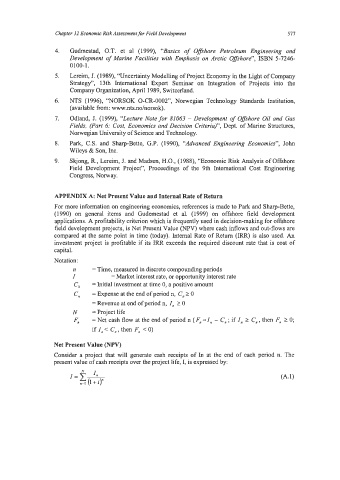Page 601 - Marine Structural Design
P. 601
Chapter 32 Economic Risk Assessment for Field Development 577
4. Gudmestad, O.T. et al (1999), “Basics of Ofshore Petroleum Engineering and
Development of Marine Facilities with Emphasis on Arctic rnshore”, ISBN 5-7246-
0100-1.
5. Lereim, J. (1989), “Uncertainty Modelling of Project Economy in the Light of Company
Strategy”, 13th International Expert Seminar on Integration of Projects into the
Company Organization, April 1989, Switzerland.
6. NTS (1 996), “NORSOK O-CR-0002”, Norwegian Technology Standards Institution,
(available from: www.nts.no/norsok).
7. Odland, J. (1999), “Lecture Note for 81063 - Development of Offshore Oil and Gas
Fields, (Part 6: Cost, Economics and Decision Criteria)”, Dept. of Marine Structures,
Norwegian University of Science and Technology.
8. Park, C.S. and Sharp-Bette, G.P. (1990), “Advanced Engineering Economics”, John
Wileys & Son, Inc.
9. Skjong, R., Lereim, J. and Madsen, H.O., (1988), “Economic Risk Analysis of Offshore
Field Development Project”, Proceedings of the 9th International Cost Engineering
Congress, Norway.
APPENDIX A: Net Present Value and Internal Rate of Return
For more information on engineering economics, references is made to Park and Sharp-Bette,
(1990) on general items and Gudemestad et al. (1999) on offshore field development
applications. A profitability criterion which is frequently used in decision-making for offshore
field development projects, is Net Present Value (NF’V) where cash inflows and out-flows are
compared at the same point in time (today). Internal Rate of Return (IRR) is also used. An
investment project is profitable if its IRR exceeds the required discount rate that is cost of
capital.
Notation:
n = Time, measured in discrete compounding periods
I = Market interest rate, or opportunity interest rate
C, = Initial investment at time 0, a positive amount
C, = Expense at the end of period n, C,, 1 0
= Revenue at end of period n, I,, 1 0
N = Project life
F,, = Net cash flow at the end of period n (F,, =I,, - C, ; if I, 2 C,, , then F,, 2 0;
ifI,,<C,,thenF,,<O)
Net Present Value (NPV)
Consider a project that will generate cash receipts of In at the end of each period n. The
present value of cash receipts over the project life, I, is expressed by:
I=C- In
(1 + i)”

